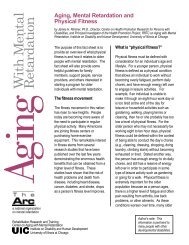Bridging the Aging and Developmental Disabilities Service ... - rrtcadd
Bridging the Aging and Developmental Disabilities Service ... - rrtcadd
Bridging the Aging and Developmental Disabilities Service ... - rrtcadd
Create successful ePaper yourself
Turn your PDF publications into a flip-book with our unique Google optimized e-Paper software.
• Deeply entrenched cultural differences with different conceptualizations–, with <strong>the</strong><br />
disability community historically being resistant to medicalization, given a strong activist<br />
movement geared towards empowerment <strong>and</strong> independence <strong>and</strong> adherence to <strong>the</strong> social<br />
model emphasizing societal barriers as major causes of disability.<br />
• Reluctance of older people who experience <strong>the</strong> onset of impairments (or disability) in late<br />
life to be labeled as having a disability <strong>and</strong> to be included in programs for people with<br />
lifelong disabilities.<br />
• Differences in principles <strong>and</strong> values underlying such concepts as “person-centered<br />
planning” <strong>and</strong> <strong>the</strong>ir implementation (e.g., engaging individuals in looking for creative<br />
ways to meet <strong>the</strong>ir needs versus presenting <strong>the</strong>m with current service options).<br />
• Reluctance of one sector to share resources <strong>and</strong> funds with <strong>the</strong> o<strong>the</strong>r, given perceptions of<br />
more resource availability in <strong>the</strong> DD network <strong>and</strong> of increasing budgetary constraints in<br />
both sectors.<br />
• Different organization <strong>and</strong> delivery of funding (e.g., pathway to services, waiting lists,<br />
entitlements).<br />
• Fear that <strong>the</strong> needs of one group might be short changed to <strong>the</strong> policy agenda of <strong>the</strong> o<strong>the</strong>r.<br />
• Lack of knowledge of aging in <strong>the</strong> disability sector<br />
<strong>and</strong> lack of knowledge of disability in <strong>the</strong> aging<br />
sector.<br />
The aging service system has adopted <strong>the</strong> disability<br />
community’s ingrained philosophies of self-direction,<br />
person-centered planning, <strong>and</strong> participant- directed services.<br />
Yet, disparities in <strong>the</strong>ir implementation coupled with<br />
differences in <strong>the</strong> structure of <strong>the</strong> aging <strong>and</strong> DD service<br />
systems <strong>and</strong> <strong>the</strong> services <strong>the</strong>y provide are often barriers to<br />
collaboration (<strong>the</strong>re are exceptions – particularly in<br />
situations where key staff have experienced employment in<br />
both sectors). Older Americans Act programs serve a large<br />
number of people at a relatively low cost per person. 21 In<br />
contrast people with developmental disabilities often require<br />
intensive staff support to provide varying degrees of skills<br />
training, personal assistance services, <strong>and</strong> supervision.<br />
People with developmental disabilities consumed 72% of<br />
2006 Medicaid waiver expenditures although <strong>the</strong>y accounted<br />
for only 40% of waiver enrollees. 22 The 2008 average per<br />
capita expenditure for home <strong>and</strong> community based services<br />
under <strong>the</strong> 1915 (c ) Medicaid waiver was $42,896 for people<br />
“We have a silo for older<br />
adults <strong>and</strong> we have silos<br />
for people with<br />
developmental disabilities.<br />
Although <strong>the</strong>re are<br />
similarities <strong>and</strong><br />
differences, <strong>the</strong>se silos are<br />
not communicating or<br />
sharing or working<br />
toge<strong>the</strong>r to really<br />
underst<strong>and</strong> <strong>the</strong> supports<br />
that are needed. I don't<br />
think we have developed,<br />
in most states, a sufficient<br />
infrastructure to address<br />
<strong>the</strong> needs of aging<br />
individuals with<br />
developmental<br />
disabilities.” (UCEDD<br />
administrator)<br />
<strong>Bridging</strong> <strong>the</strong> <strong>Aging</strong> <strong>and</strong> <strong>Developmental</strong> <strong>Disabilities</strong> <strong>Service</strong> Networks Page 18



